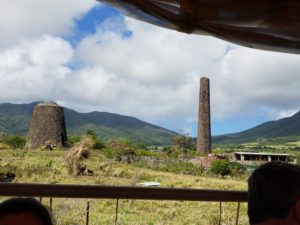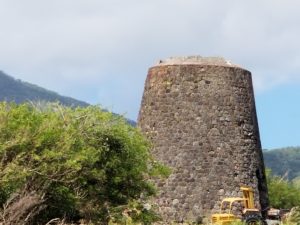As an economic historian who studies the antebellum South, and one who lived in Louisiana while learning their trade, sugar is something that has always interested me. Sugar was an industrial enterprise, and took a large amount of both technology and organization to realize the potential profits of this “white gold.” Recently, I was on vacation in St. Kitts, and did a tour there riding the St. Kitts Sugar Train (you can visit their website here). This train was built in 1912 to serve the sugar plantations on the island. While the plantations are gone, and in many cases are being used to build cheap housing for the island’s inhabitants, the train is still there. While on that train, I could still see the remnants of the old sugar mills, both the stacks of the boiling houses and the remains of the windmills used to power the plants. These pictures are a stark reminder of the impact of sugar on these areas. This post is not meant to be a complete review of the history of sugar on the island, even though there are a few tidbits about it below. My purpose is to remind myself, and others, that the effects of these past events are ever present on the landscape. History is not just the study of the past, it is a study of the impact that past still has today. I was reminded of this on my train ride.



Slave labor was used to produce sugar for colonial masters, and this island was a major part of Britain’s sugar wealth in the Caribbean. Vincent Hubbard, in his work on the island, put the population of St. Kitts in 1724 as 4000 white and 11,500 black. By 1774, the white population had declined to 1,900, while the black population, mostly enslaved, had expanded to 23,462. This was a common occurrence in slave-holding areas growing cash crops in this period, a pattern that the southern United States followed. After the end of slavery in 1834, sugar continued to be produced, but it went into decline. But, even in decline, it still dominated the island until very recently, and St. Kitts is still working to find a new economic balance where tourism is the major employer for the island.
While my upcoming book on industry in the Gulf South from the LSU Press, Industrial Development and Manufacturing in the Antebellum Gulf South: A Reevaluation, does not discuss sugar much, as the census schedules I needed for Louisiana were incomplete, missing, or damaged, this is something that needs to be reviewed much deeper in the future. I am starting to work on research to see how the use of slaves in industrialized sugar processing impacted later industrial development in the South, but seeing the remains of these sugar works reminded me that the scale of my research should be much larger.
The railway tour makes a complete circuit of the island—18 miles (30 kilometers) by train followed by 12 miles (19 kilometers) by tour bus.
The railway tour makes a complete circuit of the island—18 miles (30 kilometers) by train followed by 12 miles (19 kilometers) by tour bus.
[url=https://www.facebook.com/Come-dimagrire-101058581653226/]come dimagrire[/url]
Недавно наткнулся на требования Технического регламента для[url=https://zen.yandex.ru/media/id/5eb54898a9db2404f2bc5629/pokupaem-nizkovoltnoe-oborudovanie-dlia-kvartiry-i-doma-na-chto-obratit-vnimanie-5ebe61b0c210ab103fb3d235] низковольтного оборудования[/url]. Интересную статью на эту тему нашел у electrotorg.ru
[url=https://www.facebook.com/Reduslim-101958461562598/ ]reduslim[/url]